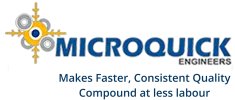Understanding the Latest Trends and Innovations in Rubber Compounding
Brief overview of rubber compounding and its significance in various industries
Rubber compounding plays a crucial role in many industries, from automotive and aerospace to consumer products and healthcare. By incorporating additives, fillers, and polymers, compounding enhances the performance and properties of rubber materials, enabling diverse applications.
Importance of staying updated with the latest trends and innovations in rubber compounding
Staying at the forefront of rubber compounding trends and innovations is essential for businesses to maintain a competitive edge. This knowledge enables the development of advanced rubber compounds that meet evolving industry demands and regulatory requirements.
How Microquick Engineers’ Hydraulic Dispersion Kneaders contribute to the advancements in rubber compounding
Microquick Engineers offers state-of-the-art Hydraulic Dispersion Kneaders that improve the rubber compounding process by providing automated continuous hydraulic compression on ingredients. This results in excellent quality compounding, faster batch preparation, and consistent performance across various industries.
Key Trends in Rubber Compounding
Several emerging trends in rubber compounding reflect the industry’s response to global challenges, technological advancements, and shifting market dynamics. These trends include a growing focus on sustainability, the application of advanced technology, the impact of the automotive industry slowdown, and the geographical distribution of the rubber compound market.
Sustainability and eco-friendly materials are becoming increasingly important in rubber compounding. Manufacturers are now seeking environmentally responsible alternatives to traditional materials, driven by regulatory requirements and consumer demand. This shift has led to the development of innovative bio-based polymers and renewable additives that minimize environmental impact while maintaining performance.
Advanced technology is also shaping the rubber compounding industry, as manufacturers leverage innovative techniques to improve material properties and production efficiency. For example, new curing processes and mixing methods enhance the dispersion of ingredients, leading to superior rubber compounds. Additionally, the use of automation and data analytics in production processes can optimize resource utilization and reduce waste.
The automotive industry, a major end-use market for rubber compounds, is experiencing a slowdown, which impacts rubber compounding. Manufacturers must adapt to changing demand patterns by diversifying their product offerings and targeting other industries, such as construction, healthcare, and consumer products.
Lastly, the geographical distribution of the rubber compound market plays a crucial role in shaping industry trends. Asia Pacific dominates the market, with significant growth potential in emerging economies such as China and India. Europe and North America also hold substantial market shares, with manufacturers focusing on innovation and sustainability to maintain competitiveness in these mature markets.
Innovations in Rubber Compounding
As the rubber compounding industry evolves, manufacturers are continuously seeking innovative solutions to enhance material properties and performance. Key innovations include the development of new polymer materials and additives, smart rubber compounds with self-healing capabilities, and the incorporation of nanotechnology in rubber compounding.
New polymer materials and additives are being introduced to improve the performance of rubber compounds. These innovations enable manufacturers to tailor rubber compounds to meet specific application requirements, enhancing properties such as strength, durability, and elasticity. In addition, the use of bio-based polymers and renewable additives aligns with the growing focus on sustainability and eco-friendly materials in the industry.
Smart rubber compounds with self-healing capabilities are another notable innovation. These materials can autonomously repair damage, such as cracks or punctures, by incorporating microcapsules filled with a healing agent. When the material is damaged, the capsules release the healing agent, which then reacts with the surrounding rubber to form new cross-links, restoring the material’s integrity and performance.
Nanotechnology is also making its way into rubber compounding, offering new opportunities to enhance material properties at the molecular level. By incorporating nano-sized particles or structures into rubber compounds, manufacturers can achieve significant improvements in properties such as strength, durability, and thermal stability. Nanotechnology also enables the development of multi-functional rubber compounds with unique characteristics, such as electrical conductivity or self-cleaning capabilities.
Microquick Engineers’ Hydraulic Dispersion Kneaders: A Solution for Improved Rubber Compounding
Microquick Engineers’ Hydraulic Dispersion Kneaders offer an advanced solution for rubber compounding, providing numerous technical benefits and industry-specific applications. These kneaders deliver an optimized compounding process, ensuring high-quality rubber materials for various industries.
Key features and technical benefits of the Hydraulic Dispersion Kneaders
Microquick’s Hydraulic Dispersion Kneaders offer several technical advantages, including automated continuous hydraulic ram pressure on ingredients for improved dispersion and consistent quality compounding. They also provide faster batch preparation time, wear resistance of the mixing chamber, anti-breakage properties of rotors, innovative shaft seals with lubrication passage to prevent ingredient leaks, and low energy consumption.
Industries benefiting from Microquick Engineers’ Hydraulic Dispersion Kneaders
Several industries benefit from the use of Microquick Engineers’ Hydraulic Dispersion Kneaders, including automotive, industrial, consumer products, healthcare, and electrical. These kneaders cater to the specific compounding requirements of each sector, ensuring high-performance rubber materials for diverse applications.
Unique selling points of the Hydraulic Dispersion Kneaders
The Hydraulic Dispersion Kneaders offer several unique selling points, such as excellent quality compounding, faster production, automated consistent quality batch preparation, value of investment, good performance for stop leak and fly of ingredients, operator-friendly design, and compact size. These features make the kneaders an ideal choice for businesses seeking to enhance their rubber compounding capabilities.
The Impact of COVID-19 and the Russia-Ukraine War on the Rubber Compound Market
The rubber compounding industry faces significant challenges due to the COVID-19 pandemic and the Russia-Ukraine war. These external factors have disrupted supply chains, impacted production, and shifted market dynamics, necessitating strategic adaptations and offering potential for future growth and recovery.
Challenges faced by the rubber compounding industry due to the pandemic and conflict
The pandemic has disrupted global supply chains and imposed restrictions on production, affecting the availability and cost of raw materials for rubber compounding. Similarly, the Russia-Ukraine war has led to geopolitical tensions and economic sanctions, further exacerbating supply chain disruptions and market volatility.
Strategies for adapting to the changing market landscape
To navigate these challenges, rubber compounding manufacturers must adopt strategic measures such as diversifying their supplier base, exploring alternative raw materials, and enhancing production efficiency. Additionally, companies can leverage digital transformation and automation to optimize operations and mitigate risks associated with labor shortages and production disruptions.
Potential for growth and recovery in the coming years
Despite the challenges, the rubber compounding industry holds potential for growth and recovery in the coming years. Factors such as increasing demand for eco-friendly materials, technological advancements, and infrastructure development projects can drive market expansion. Furthermore, the industry can benefit from regional growth opportunities, particularly in emerging economies with robust manufacturing sectors, such as China and India.
Conclusion
Staying informed about the latest trends and innovations in rubber compounding is crucial for businesses to remain competitive and adapt to the dynamic market landscape. Embracing new materials, technologies, and sustainability initiatives can help companies develop advanced rubber compounds that meet evolving industry demands and regulatory requirements.
Microquick Engineers’ Hydraulic Dispersion Kneaders provide a competitive edge in the rubber compounding industry, offering numerous technical benefits and industry-specific applications. By leveraging these advanced kneaders, businesses can enhance their rubber compounding capabilities and deliver high-quality materials for various industries, ensuring long-term growth and success.
Discover Rubber Compounding Solutions
Keeping up with the latest trends and innovations in rubber compounding is essential for businesses to stay competitive and adapt to the ever-changing market landscape. Microquick Engineers’ Hydraulic Dispersion Kneaders provide a competitive edge by offering numerous technical benefits and industry-specific applications.
Learn more about Microquick Engineers and their Hydraulic Dispersion Kneaders to enhance your rubber compounding capabilities. To discuss your rubber compounding needs, request a brochure or schedule a consultation with our experts today.

